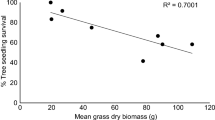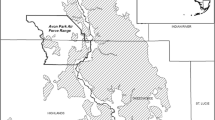Abstract
African grasses, introduced into Neotropical savannas to improve forage quality, have spread successfully and displaced native plants. To understand their competitive relationships, we compared biomass production and allocation, plant architecture and phenology, net photosynthesis (Pn), water relations, and nutrient content under fire and simulated herbivory between two C4 grasses, the native Trachypogon plumosus and the introduced Hyparrhenia rufa from a seasonal savanna in Venezuela. All variables were strongly influenced by the rainfall regime. Hyparrhenia produced bigger plants (in mass and size) with a large proportion of mass (>75%) allocated to leaves and culms. Its biomass production was more affected by fire than by defoliation. In contrast, Trachypogon was more affected by defoliation than by fire which promoted a flush of leaf growth even in the dry season. Fire caused up to 85% mortality in Hyparrhenia but none in Trachypogon where it increased inflorescence production. However, fire promoted abundant seed germination and fast seedling growth in Hyparrhenia, enabling it to colonize new areas. During the growing season Trachypogon had higher Pn and lower leaf water potential (Ψ) than Hyparrhenia but differences among treatments were not significant for either grass. Pn of Trachypogon ceased at a lower Ψ (−3.0 MPa) than in Hyparrhenia (−2.0 MPa), indicating its higher tolerance to water stress. During the dry season, Trachypogon leaves remained alive and retained low Pn. Leaf nutrient content was higher during the rainy season in both species. Differences in Pn could not explain the higher seasonal biomass production of Hyparrhenia. However, its water stress evasion strategy, larger biomass allocated to leaves, abundant germination and fast seedling growth appeared to be responsible for the success of Hyparrhenia as an invader of Neotropical savannas.
Similar content being viewed by others
Author information
Authors and Affiliations
Additional information
Received: 17 August 1998 / Accepted: 3 March 1999
Rights and permissions
About this article
Cite this article
Baruch, Z., Bilbao, B. Effects of fire and defoliation on the life history of native and invader C4 grasses in a Neotropical savanna. Oecologia 119, 510–520 (1999). https://doi.org/10.1007/s004420050814
Issue Date:
DOI: https://doi.org/10.1007/s004420050814




